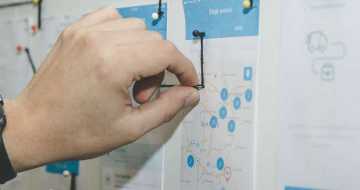- Blog
- Cultivating innovation: An introduction to the innovation evidence-based management learning team
Contents
What is Innovation?
Concepts like “innovation”, “disruption”, and “creativity” are frequently discussed in organizational settings these days. Most organizations recognize that distinctive, original ideas can generate profit, locate a new business niche, and solve ongoing problems. However, a great deal of the professional discussion about creativity and innovation is somewhat vague – and not rooted in the decades-long history of psychological research into the subject.
In psychology, and in management research, innovation is clearly defined: for an idea to be truly innovative, it must feature novelty, plus usefulness (Randel & Jaussi, 2017). Innovative thinkers and work teams generate ideas that are rare and distinctive, but not so outlandish as to be difficult to implement. A large part of innovation, in addition is problem finding – locating areas of potential improvement that have eluded others (Cheng, Hu, Jia, & Runco, 2016).
Measuring Innovation Potential
When hiring and making promotion decisions, managers should examine prospects’ capacity for innovative thinking. Numerous psychological studies have been conducted on the factors that predict, or signal, creative potential. Innovation potential appears to be related to numerous individual-level factors, including personality type, honesty, and comfort with risk-taking (Sellier & Dahl, 2015). This EBLMT will review the latest research on employee traits that signal high creativity potential.
In addition to looking at predictors or correlates of creativity, psychologists have developed numerous creativity tests, which can be used to screen employees or to practice innovative thinking within previously existing work teams. Tests such as the “uses for a brick” test have been carefully vetted and validated over decades; managers can use these tests to help strengthen team members’ creative muscles, or to identify the most outgoing, distinctive thinkers within an organization (Guilford, 1975). This EBMLT will review these tests and provide managers with instructions in how to use them.
Forming and Managing Innovative Groups
Innovation within an organization is often a team effort. Few disruptive, paradigm-shifting ideas are the work of a single, isolated genius. Thus, it is vital that a manager learn how to create teams that can work together to craft innovative ideas. Evidence suggests that the composition of the team has a large impact, as do the social dynamics present on the team.
Managers seeking to craft creative teams should, generally, work to increase diversity. Diverse teams experience greater conflict in the short term, but generate a higher volume and wider breadth of ideas in the long term (Friedman, Friedman, & Leverton, 2016). However, diversifying a work group cannot end with recruitment of a variety of types of people: diversity must be embraced by management, and accommodated, throughout the entire process. This EBLMT will review the best practices in creating a varied, creative, diverse team, and managing diversity effectively.
Once an innovation team is created, management and group policies can either facilitate distinctive thinking, or quash it. Proper procedures must be in place to rid team members of their inhibitions, so they feel comfortable generating tons of ideas and taking creative risks (Farh, Lee, & Farh, 2010). In addition, a fair process must be used to evaluate and cull ideas after they are generated. Managers must take pains to reduce resentment and maintain organizational warmth throughout all these steps. This EBLMT will provide managers with useful tips for accomplishing these goals.
Management skills newsletter
Join our monthly newsletter to receive management tips, tricks and insights directly into your inbox!
Key Take-Aways of the Innovation EBLMT
CQ Net utilizes an agile learning approach to help busy managers learn about the latest social science findings in an efficient, practical way. The research literature is distilled and communicated in a manager-friendly fashion, ensuring that you receive best-practice tips and summaries of empirical results and theories in far less time than it would take to review the literature yourself.
This innovation-focused EBLMT features focused, practical, and approachably-written dossiers on how innovation is defined, how a manager can go about measuring innovation, and how to recruit and build teams that will excel in creative work. In addition, this EBLMT provides key insights into organizational-level factors that can influence innovative success: how to craft an organizational culture that foments creativity, brainstorming processes that benefit creativity, and how to avoid problematic “creativity killers” that harm many organizations. Each dossier is rooted in cutting-edge psychological research, and is written with a management audience in mind. As a member of this learning team, you will discuss challenging issues with peers, work with a trained, professional instructor with expertise in social psychology, and refine your own understanding of management strategies that will benefit your organization.
References and further reading
Cheng, L., Hu, W., Jia, X., & Runco, M. A. (2016). The different role of cognitive inhibition in early versus late creative problem finding. Psychology of Aesthetics, Creativity, and the Arts, 10(1), 32.
Farh, J. L., Lee, C., & Farh, C. I. (2010). Task conflict and team creativity: a question of how much and when. Journal of Applied Psychology, 95(6), 1173.
Friedman, H. H., Friedman, L. W., & Leverton, C. (2016). Increase diversity to boost creativity and enhance problem solving. Psychosociological Issues in Human Resource Management, 4(2), 7-33.
Guilford, J. P. (1975). Varieties of creative giftedness, their measurement and development. Gifted Child Quarterly, 19(2), 107-121.
Randel, A. E., & Jaussi, K. S. (2017). Leading for uniqueness: The role of uniqueness in facilitating creativity in employees’ self-concepts. In The Creative Self (pp. 289-299).
Sellier, A. L., & Dahl, D. W. (2015). The light side of creativity: An honesty mindset can boost creativity. ACR North American Advances.
Top Rated
About the Author

Comments
Most Read Articles
Blog Categories
RELATED SERVICES









Add comment